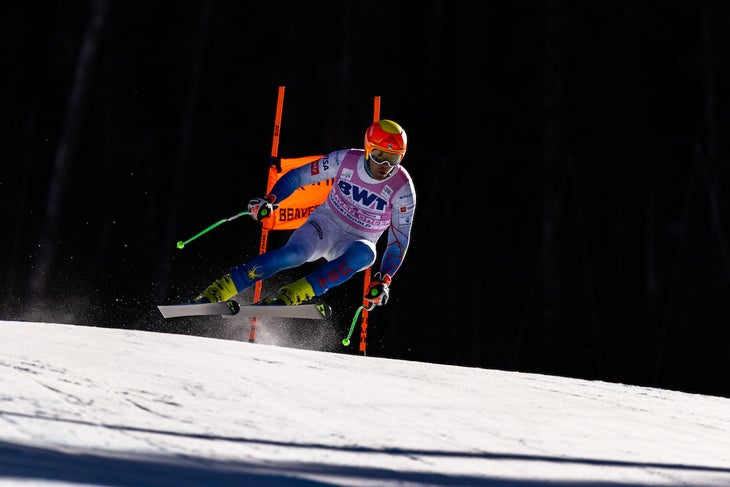Products You May Like
When Steven Nyman did not make the 2022 U.S. Olympic Team last winter, many ski fans probably assumed the 40-year-old veteran would hang up his race skis. After all, just months earlier, he had blown out his Achilles tendon—another in a long list of injuries he has suffered over two decades of racing.
But not Nyman. The Tom Brady of the U.S. Ski Team, Nyman is training hard for the coming season and heads to Chile on August 10 to get on snow. He plans to ski almost all of the World Cup downhills and super-Gs this winter, and world championships too.
Related: U.S. to host two additional World Cup races in 2022-’23
Why? Because the father of two still loves the sport and believes that he can do even better. Thanks to the body work that he has committed to—not just physical training but rebalancing his body after all the hits it has taken—he has remained competitive at an age when most ski racers have long since retired.
“My career isn’t a career of ease,” Nyman said by phone, then listed his tally of injuries: “I’ve torn both Achilles tendons, broken both legs, and blown out both knees.”
It’s remarkable that he still even can compete. But with improvements in medicine, physiology, and funding, athletes like Nyman (and Brady) are redefining what it means to age.
Finding body balance
Nyman jumped onto skiing’s radar in 2002 after he won the World Junior Slalom title, then claimed second in combined—sharing both podiums with Aksel Lund Svindal, who would go on to become a two-time Olympic Champion and five-time World Champion. Over the next 15 years, Nyman focused on speed skiing, tallying 11 World Cup podiums in downhill, including three wins, and competing in three Olympics.
But when he crashed, he crashed hard.
“I never had an injury in the middle of a turn,” he said. “My injuries always came from [the equivalent of] falling out of a three-story building or hitting a wall going 60 miles an hour.”

After winning his first Europa Cup downhill in 2004, Nyman broke his leg and had a rod inserted to stabilize the bone. He was in constant pain after surgery until his friend Torah Bright, the 2010 Olympic Snowboard Halfpipe Champion, convinced him to see Craig Buhler, a chiropractor in Salt Lake City who specializes in the AMIT Method, a specific technique that neurologically turns on muscles that have been turned off due to injury or trauma.
“I couldn’t do a single-leg squat,” said Nyman. “I walked out of there with a full-range leg squat, pain free.”
It made Nyman realize that he could only build a solid foundation in ski racing if he had a solid physical foundation, with every muscle firing.
“Every time Steve falls or has a big hit, I reevaluate him and figure out how many muscles have been turned off in the neck, shoulders, back, hips, knees, Achilles,” explained Kelly Farmer, who now works with Nyman weekly at the Buhler Athletic Injuries & Human Performance Clinic. “He blew out his Achilles last year and within three months, we were able to get him back on snow, which is unheard of.”
Related: Strengthen your hips and stop making your legs do all the work
“My specialty is erasing his injuries,” added Farmer, who says the clinic’s motto is “you should be getting better with age.”
Nyman credits Buhler and Farmer with his longevity. But Farmer gives the credit back to Nyman.
“Steve’s pursuit and drive for human performance is bar none,” added Farmer. “He is not satisfied with tight hips. He’s not satisfied with people saying, ‘Oh, it will take a year to rehab your Achilles.’ He wants to push it to where he can be fully strong and capable at all times. We are just lucky enough to have crossed paths.”
When does old become too old?
The advances in human performance that clinics like Buhler’s have made beg the question: Is there an age that makes someone too old to ski race?
Twenty years ago, many thought so, especially after Bill Johnson—the first U.S. man to win an Olympic downhill gold medal in 1984—crashed and suffered a traumatic brain injury while trying to make a comeback at age 40. It was March 2001, and Nyman, who had just turned 19, was competing in the same race.
But fast forward to 2022, and 40-year-old Nyman is not the same athlete as 40-year-old Johnson, who had not competed in over a decade when he tried to make his comeback.
“Your body adapts [to forces] through time,” explained Nyman, who has been on the U.S. Ski Team for 21 consecutive years. “If you take 10 years off, you’re not ready. You may have that competitive fire and that belief in your head, but you’re not ready.”
And Nyman is not the oldest guy on the World Cup tour. That honor belongs to Johan Clarey, the French skier who won the Olympic silver medal in downhill at the 2022 Beijing Games. Clarey is the real Tom Brady of ski racing, said Nyman.
So how long will Nyman stay in the game? As long as he thinks he can compete at the top.
His career must also coalesce with his family life. His wife, Charlotte Moats, worked as the U.S. Ski Team’s chief of staff and oversaw the team at the Olympics for several years, allowing her to travel with Nyman during the winter. They then took a page from professional cycling and moved the whole family to Innsbruck for the winter (U.S. cyclists live in Europe so they can go home between races). But Moats now has a new job now and is less mobile. Their oldest daughter is five and will start school soon; their youngest daughter turns two in October and is a very busy toddler.
“As long as Charlotte gives me a thumbs up and physically, I feel capable,” said Nyman, “I’m in.”
